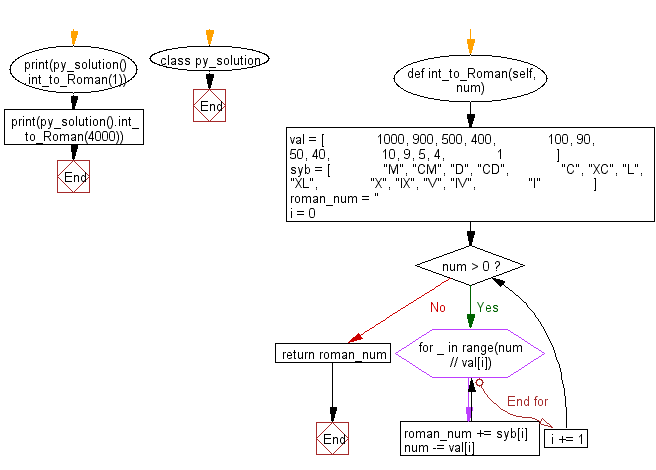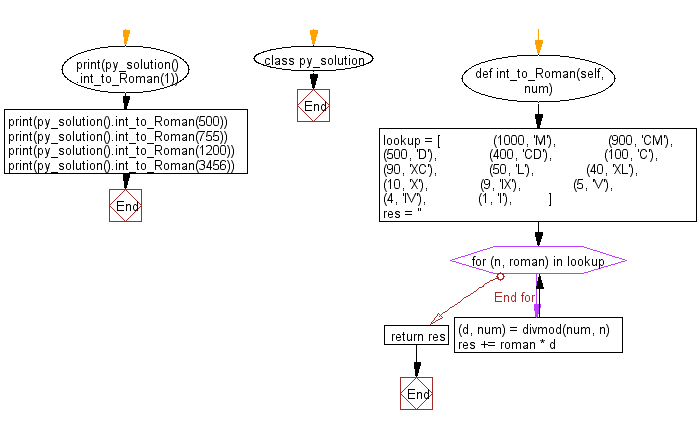Python: Convert an integer to a roman numeral
Python Class: Exercise-1 with Solution
Write a Python class to convert an integer to a roman numeral.
Sample Solution-1:
Python Code:
class py_solution:
def int_to_Roman(self, num):
val = [
1000, 900, 500, 400,
100, 90, 50, 40,
10, 9, 5, 4,
1
]
syb = [
"M", "CM", "D", "CD",
"C", "XC", "L", "XL",
"X", "IX", "V", "IV",
"I"
]
roman_num = ''
i = 0
while num > 0:
for _ in range(num // val[i]):
roman_num += syb[i]
num -= val[i]
i += 1
return roman_num
print(py_solution().int_to_Roman(1))
print(py_solution().int_to_Roman(4000))
Sample Output:
I MMMM
Pictorial Presentation:
Flowchart:

Visualize Python code execution:
The following tool visualize what the computer is doing step-by-step as it executes the said program:
Sample Solution-2:
Convert an integer to its roman numeral representation. Accepts value between 1 and 3999 (both inclusive).
- Create a lookup list containing tuples in the form of (roman value, integer).
- Use a for loop to iterate over the values in lookup.
- Use divmod() to update num with the remainder, adding the roman numeral representation to the result.
Python Code:
class py_solution:
def int_to_Roman(self, num):
lookup = [
(1000, 'M'),
(900, 'CM'),
(500, 'D'),
(400, 'CD'),
(100, 'C'),
(90, 'XC'),
(50, 'L'),
(40, 'XL'),
(10, 'X'),
(9, 'IX'),
(5, 'V'),
(4, 'IV'),
(1, 'I'),
]
res = ''
for (n, roman) in lookup:
(d, num) = divmod(num, n)
res += roman * d
return res
print(py_solution().int_to_Roman(1))
print(py_solution().int_to_Roman(500))
print(py_solution().int_to_Roman(755))
print(py_solution().int_to_Roman(1200))
print(py_solution().int_to_Roman(3456))
Sample Output:
I D DCCLV MCC MMMCDLVI
Flowchart:

Visualize Python code execution:
The following tool visualize what the computer is doing step-by-step as it executes the said program:
Python Code Editor:
Contribute your code and comments through Disqus.
Previous: Python Class exercises.
Next: Write a Python class to convert a roman numeral to an integer.
What is the difficulty level of this exercise?
Test your Programming skills with w3resource's quiz.
Python: Tips of the Day
Find current directory and file's directory:
To get the full path to the directory a Python file is contained in, write this in that file:
import os dir_path = os.path.dirname(os.path.realpath(__file__))
(Note that the incantation above won't work if you've already used os.chdir() to change your current working directory, since the value of the __file__ constant is relative to the current working directory and is not changed by an os.chdir() call.)
To get the current working directory use
import os cwd = os.getcwd()
Documentation references for the modules, constants and functions used above:
- The os and os.path modules.
- The __file__ constant
- os.path.realpath(path) (returns "the canonical path of the specified filename, eliminating any symbolic links encountered in the path")
- os.path.dirname(path) (returns "the directory name of pathname path")
- os.getcwd() (returns "a string representing the current working directory")
- os.chdir(path) ("change the current working directory to path")
Ref: https://bit.ly/3fy0R6m
- New Content published on w3resource:
- HTML-CSS Practical: Exercises, Practice, Solution
- Java Regular Expression: Exercises, Practice, Solution
- Scala Programming Exercises, Practice, Solution
- Python Itertools exercises
- Python Numpy exercises
- Python GeoPy Package exercises
- Python Pandas exercises
- Python nltk exercises
- Python BeautifulSoup exercises
- Form Template
- Composer - PHP Package Manager
- PHPUnit - PHP Testing
- Laravel - PHP Framework
- Angular - JavaScript Framework
- Vue - JavaScript Framework
- Jest - JavaScript Testing Framework
